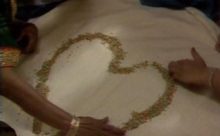The Henna Plant: Transcending Time, Religion and Culture by Tammana Begum
The henna plant has been widely used throughout the world for thousands of years, particularly within medicine and art. However, its origin and history are not well-recorded.
Despite its popular global use for copper-coloured temporary 'tattoos' and hair dyes, relatively little is known about the henna plant, Lawsonia inermis.
The plant is believed to have originated in the Middle East and North Africa, and then spread across Asia thousands of years ago. Today, henna is cultivated around the world, from South America to Japan. It can also be found growing in the wild in Pakistan and India.
This small shrub is adapted to a wide range of hot environments, including tropical and subtropical forests, shrublands, grasslands, deserts and wetlands. It can tolerate both acidic and alkali soils as well as heavy and sparse rainfall, allowing it to thrive in many countries.
Shahina Ghazanfar, a Science Research Leader at Kew Gardens says, 'Henna belongs to the genus Lawsonia, which is monotypic - this means it is the only species in its genus.'
'It was given the botanical Latin name Lawsonia inermis by Linnaeus in 1753. The generic name Lawsonia was named after Dr Issac Lawson, an eighteenth century naturalist and traveller and a friend and patron of Linnaeus. The specific name inermis means unarmed, referring to the stems being without prickles.'
How was henna discovered and what is it used for?
Henna has a low toxicity level and its wide use over millennia allowed it to become ingrained within an array of cultural and religious practices.
The plant was most likely discovered by shepherds who herded grazing animals. Its staining properties may have been identified when livestock ate the leaves, which stained their mouths red and prompted the shepherds to check for injury.
'Henna is used as a coolant in countries where summers are hot,' says Shahina. 'Henna paste smeared over soles of feet or on hair cools the body part as it dries. It’s the same principle as wearing a wet towel around your head or face to cool it. Henna paste is also used to cool off burns and headaches in some cultures.'
This practice later led to staining the skin, hair, nails and clothes for art, fashion, status and symbolism.
To make henna paste, the leaves, stems and flowers of the plant are crushed into a fine powder and mixed with water. The plant contains a copper-coloured dye molecule called lawsone, which is found in high concentration in the leaves and stems. Lawsone is released slowly when the leaves and stems are crushed, and bind to protein, creating a stain on the skin, hair and nails.
Depending on the culture, other ingredients, such as lemon juice, tea or essential oils are sometimes added to enhance the colour or increase the longevity of the stain. Colour tends to be darkest on hands and feet as that is where keratin, a type of protein, is most concentrated.
Henna has heavily-scented flowers that produce a pleasant fragrance. This has led to it being grown in gardens as an ornamental plant, as well as being used in perfumery.
The history of henna
The origin and history of henna isn't well-recorded but there is evidence showing the plant being used during Babylonian time (roughly between 1894-539 BCE).
One of the earliest uses of henna can be dated back to Ancient Egypt, where henna paste was used to stain mummies and mummy wrappings. The Egyptians believed henna retained a person's spirituality. The lawsone also made the skin stronger and resistant to decay. Some mummies have been unearthed with flaming red hair that was dyed with henna, probably at the time of embalmment.
The Ebers Papyrus - one of the oldest and most extensive records of Ancient Egyptian medicine - includes various uses of henna, such as in treatments for ringworm. The Egyptians noted that the effects of the plant depended on what type of environment it had grown in and what stage of life it was at. For example, if it grew in cool, moist soil, it wouldn't be rich in lawsone and therefore would not stain very well. A lot of the information about henna in the Ebers Papyrus is consistent with what we know today.
Henna was also important in the Mughal Empire, which ruled India between roughly 1526-1857 and was known for its lavish lifestyle, in particular through its fine art.
In both cultures, henna was used to produce intricate patterns on the bodies of men and women during special occasions, such as weddings and festivals. This art form is mostly known as mehndi throughout Asia, and India is often credited for popularising it in present day.
Henna is a symbol of joy in many religions, including Islam, Christianity, Judaism, Buddhism, Hinduism and Sikhism. Events based around weddings, births, circumcision and victories are often celebrated with mehndi.
'Moroccan Jews use henna in their traditional ceremonies, in particular weddings where elders of the family smudge henna on the palms of the bride and groom,' says Shahina.
'This is to symbolically bestow the new couple with good health, fertility, wisdom and security. This tradition is still practised in India and Pakistan and is meant to give the bride and groom a good life after marriage. Henna is believed in tradition to protect the couple from demons.'
Henna is mentioned several times in the hadith - a collection of sayings recorded by the Prophet Muhammed's close companions and followers in the eighth and ninth centuries . These include using henna to colour the hair and beard, as a medicinal treatment and to adorn the body.
The use of henna, including as mehndi, transcends religious groups and cultures, making it difficult to trace where it originated and which culture can lay claims to it.
